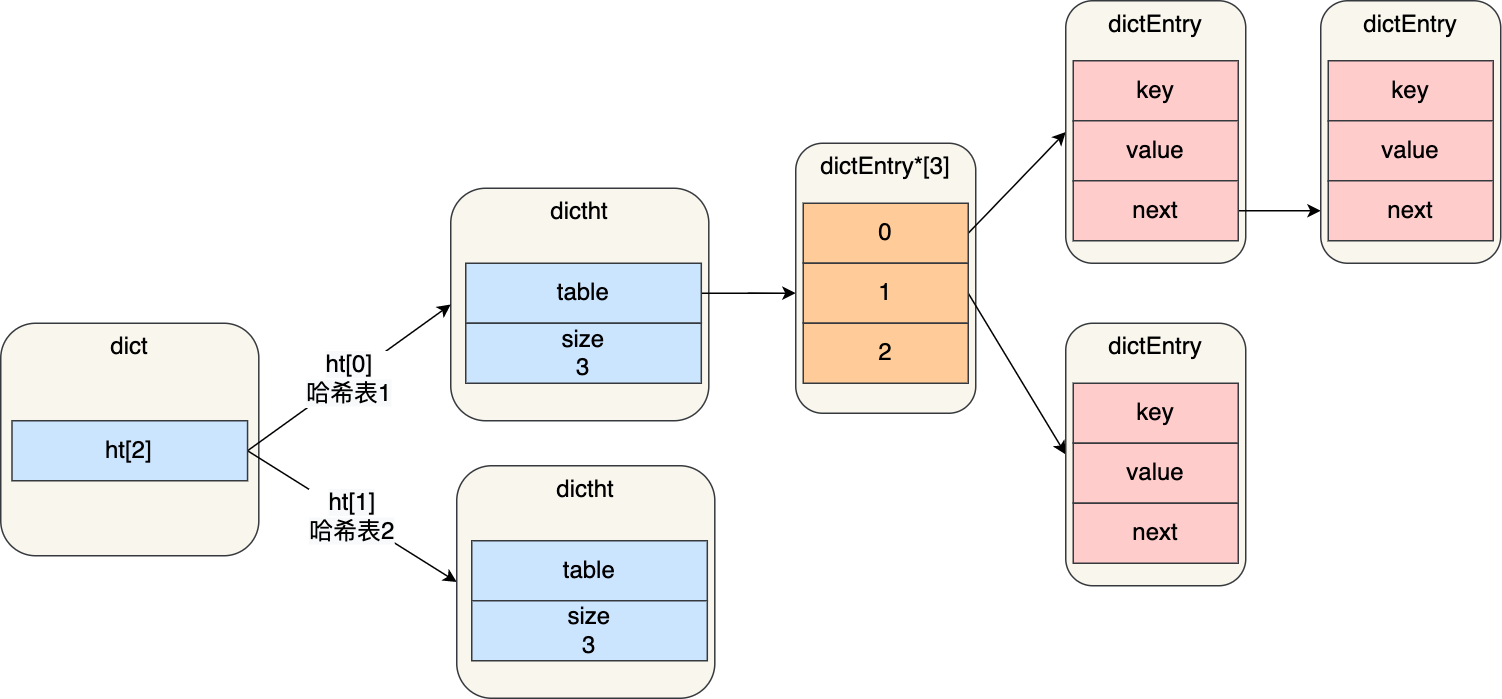哈希表实现�原理
哈希表是一种保存键值对(key-value)的数据结构。哈希表优点在于,它能以 O(1) 的复杂度快速查询数据
源码对应文件:
dict.cdict.h
源码及原理
结构设计
/* This is our hash table structure. Every dictionary has two of this as we
* implement incremental rehashing, for the old to the new table. */
typedef struct dictht {
dictEntry **table; // 哈希表数组
unsigned long size; // 哈希表大小
unsigned long sizemask; // 哈希表大小掩码,用于计算索引
unsigned long used; // 哈希表中已使用的节点数
} dictht;
哈希表底层就是一个数组,数组的每个元素是一个指向哈希节点的指针

对于每个元素节点dictEntry
typedef struct dictEntry { // 定义一个结构体 dictEntry
void *key; // 键指针
union { // 联合体,用于存储不同类型的值
void *val; // 值指针
uint64_t u64; // 无符号64位整数
int64_t s64; // 有符号64位整数
double d; // 双精度浮点数
} v; // 联合体变量 v
struct dictEntry *next; // 指向下一个字典条目的指针
} dictEntry; // 结构体类型定义为 dictEntry
void *key:这是一个指向键的指针。键可以是任何类型的数据,通过指针来存储。union:这是一个联合体,用于存储不同类型的值。联合体中的成员可以是void *val(值指针)、uint64_t u64(无符号 64 位整数)、int64_t s64(有符号 64 位整数)或double d(双精度浮点数)。联合体的特点是在同一时刻只能存储其中的一个成员。struct dictEntry *next:这是一个指向下一个字典条目的指针,用于构建链表结构,解决哈希冲突。
使用联合体的好处是节省内存空间,因为当「值」是整数或浮点数时,就可以将值的数据内嵌在 dictEntry 结构里,无需再用一个指针指向实际的值,从而节省了内存空间。
哈希冲突
哈希表实际上是一个数组,数组里多每一个元素就是一个哈希桶。当一个键值对的键经过 Hash 函数计算后得到哈希值,再将(哈希值 % 哈希表大小)取模计算,得到的结果值就是该 key-value 对应的数组元素位置,也就是第几个哈希桶。
如果说有两个元素哈希值相同,被分配到了同一个桶中,那么就是哈希冲突。
链式哈希
每个哈希表节点都有一个 next 指针,用于指向下一个哈希表节点,因此多个哈希表节点可以用 next 指针构成一个单项链表,被分配到同一个哈希桶上的多个节点可以用这个单项链表连接起来,这样就解决了哈希冲突。
随着单项链表长度的增加,耗时也会增加,因为链表查询是,要解决这个问题,就需要rehash
rehash触发条件
两个:
- 负载因子大于1,且没有执行bgsave或者bgrewiteaof,也没有RDB快照和AOF重写。
- 负载因子大于5,说明哈希冲突严重,强制rehash
rehash
typedef struct dict {
dictType *type; // 字典类型
void *privdata; // 私有数据
dictht ht[2]; // 哈希表,包含两个哈希表用于渐进式rehash
long rehashidx; /* rehashing not in progress if rehashidx == -1 */
unsigned long iterators; /* number of iterators currently running */
} dict;
Redis定义的这个dict结构体中有两个哈希表

Redis 的哈希(Hash)在存储元素数量增加或负载因子超过一定阈值时,会进行 rehash 操作,以保证哈希表的性能和效率。rehash 操作主要包括以下步骤:
- 给另一个哈希表分配空间,一般为两倍
- 迁移元素:将原哈希表中的元素重新分配到新的哈希表中,根据重新计算的哈希值找到对应的槽位,并将元素放入其中。
- 将第一个哈希表空间释放,并将第二个哈希表设置为第一个。原本的第一个哈希表为空白,为下次哈希做准备
如果在这个过程中,第一个哈希表空间很大,那么会涉及大量数据拷贝,造成Redis阻塞
渐进式hash
迁移的工作不再是一次性迁移完成,而是分多次迁移。步骤如下:
- 给第二个哈希表开空间
- 在rehash期间,每次哈希表元素增删改,除了操作,还会将哈希表1中索引位置所有kv迁移到哈希表2
- 随着客户端请求操作变多,最终在某个时间将第一个哈希表全部迁移到第二个哈希表,完成操作。
在此期间会有两个哈希表,增删改查会在两个哈希表上进行。
- 查找:先在第一个找,找不到去第二个找
- 新增,直接新增到第二个,这样保证第一个哈希表在不断减少
/* Performs N steps of incremental rehashing. Returns 1 if there are still
* keys to move from the old to the new hash table, otherwise 0 is returned.
*
* Note that a rehashing step consists in moving a bucket (that may have more
* than one key as we use chaining) from the old to the new hash table, however
* since part of the hash table may be composed of empty spaces, it is not
* guaranteed that this function will rehash even a single bucket, since it
* will visit at max N*10 empty buckets in total, otherwise the amount of
* work it does would be unbound and the function may block for a long time. */
/* 执行N步增量rehash。如果仍有键需要从旧哈希表移动到新哈希表,则返回1,否则返回0。
*
* 注意,rehash步骤包括将一个桶(可能有多个键,因为我们使用链表)从旧哈希表移动到新哈希表,
* 然而,由于部分哈希表可能由空白空间组成,因此不能保证此函数会rehash一个桶,
* 因为它最多会访问N*10个空桶,否则它执行的工作量将是无限的,函数可能会阻塞很长时间。 */
int dictRehash(dict *d, int n) { // 定义函数dictRehash,参数为字典指针d和整数n
int empty_visits = n*10; /* Max number of empty buckets to visit. */ // 定义变量empty_visits,最大空桶访问次数为n*10
unsigned long s0 = d->ht[0].size; // 获取哈希表0的大小
unsigned long s1 = d->ht[1].size; // ��获取哈希表1的大小
if (dict_can_resize == DICT_RESIZE_FORBID || !dictIsRehashing(d)) return 0; // 如果禁止调整大小或不在rehash中,返回0
if (dict_can_resize == DICT_RESIZE_AVOID && // 如果调整大小设置为避免,并且满足以下条件
((s1 > s0 && s1 / s0 < dict_force_resize_ratio) || // 如果哈希表1大于哈希表0且比例小于强制调整大小比例
(s1 < s0 && s0 / s1 < dict_force_resize_ratio))) // 或者哈希表0大于哈希表1且比例小于强制调整大小比例
{
return 0; // 返回0
}
while(n-- && d->ht[0].used != 0) { // 当n大于0且哈希表0中有元素时
dictEntry *de, *nextde; // 定义字典条目指针de和nextde
/* Note that rehashidx can't overflow as we are sure there are more
* elements because ht[0].used != 0 */
/* 注意rehashidx不会溢出,因为我们确定有更多元素,因为ht[0].used != 0 */
assert(d->ht[0].size > (unsigned long)d->rehashidx); // 断言哈希表0的大小大于rehash索引
while(d->ht[0].table[d->rehashidx] == NULL) { // 当哈希表0的当前rehash索引处为空时
d->rehashidx++; // 增加rehash索引
if (--empty_visits == 0) return 1; // 如果空桶访问次数用完,返回1
}
de = d->ht[0].table[d->rehashidx]; // 获取当前rehash索引处的字典条目
/* Move all the keys in this bucket from the old to the new hash HT */
/* 将此桶中的所有键从旧哈希表移动到新哈希表 */
while(de) { // 当字典条目不为空时
uint64_t h; // 定义64位无符号整数h
nextde = de->next; // 获取下一个字典条目
/* Get the index in the new hash table */
/* 获取新哈希表中的索引 */
h = dictHashKey(d, de->key) & d->ht[1].sizemask; // 计算新哈希表中的索引
de->next = d->ht[1].table[h]; // 将当前字典条目的下一个指针指向新哈希表中的对应位置
d->ht[1].table[h] = de; // 将新哈希表中的对应位置指向当前字典条目
d->ht[0].used--; // 减少哈希表0的已使用节点数
d->ht[1].used++; // 增加哈希表1的已使用节点数
de = nextde; // 将当前字典条目指向下一个字典条目
}
d->ht[0].table[d->rehashidx] = NULL; // 将哈希表0的当前rehash索引处置为空
d->rehashidx++; // 增加rehash索引
}
/* Check if we already rehashed the whole table... */
/* 检查我们是否已经rehash了整个表... */
if (d->ht[0].used == 0) { // 如果哈希表0中没有已使用节点
zfree(d->ht[0].table); // 释放哈希表0的内存
d->ht[0] = d->ht[1]; // 将哈希表1赋值给哈希表0
_dictReset(&d->ht[1]); // 重置哈希表1
d->rehashidx = -1; // 将rehash索引置为-1
return 0; // 返回0
}
/* More to rehash... */
/* 还有更多需要rehash... */
return 1; // 返回1
}